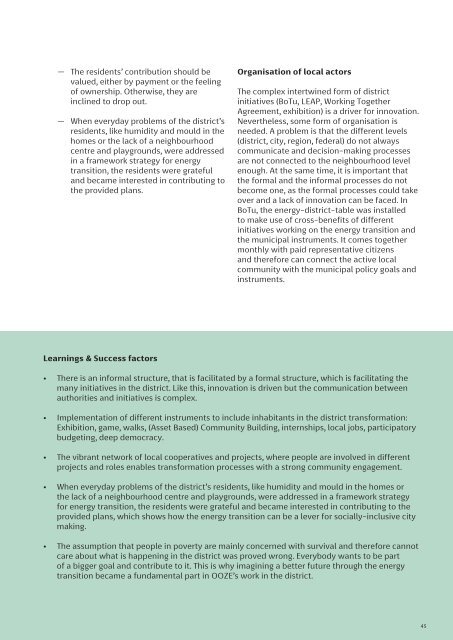Cities4PEDs Atlas_November 2021.pdf
Atlas - From 7 case interviews to recurring strategies and PED relevant aspects
Atlas - From 7 case interviews to recurring strategies and PED relevant aspects
- No tags were found...
Create successful ePaper yourself
Turn your PDF publications into a flip-book with our unique Google optimized e-Paper software.
— The residents’ contribution should be<br />
valued, either by payment or the feeling<br />
of ownership. Otherwise, they are<br />
inclined to drop out.<br />
— When everyday problems of the district’s<br />
residents, like humidity and mould in the<br />
homes or the lack of a neighbourhood<br />
centre and playgrounds, were addressed<br />
in a framework strategy for energy<br />
transition, the residents were grateful<br />
and became interested in contributing to<br />
the provided plans.<br />
Organisation of local actors<br />
The complex intertwined form of district<br />
initiatives (BoTu, LEAP, Working Together<br />
Agreement, exhibition) is a driver for innovation.<br />
Nevertheless, some form of organisation is<br />
needed. A problem is that the different levels<br />
(district, city, region, federal) do not always<br />
communicate and decision-making processes<br />
are not connected to the neighbourhood level<br />
enough. At the same time, it is important that<br />
the formal and the informal processes do not<br />
become one, as the formal processes could take<br />
over and a lack of innovation can be faced. In<br />
BoTu, the energy-district-table was installed<br />
to make use of cross-benefits of different<br />
initiatives working on the energy transition and<br />
the municipal instruments. It comes together<br />
monthly with paid representative citizens<br />
and therefore can connect the active local<br />
community with the municipal policy goals and<br />
instruments.<br />
Learnings & Success factors<br />
• There is an informal structure, that is facilitated by a formal structure, which is facilitating the<br />
many initiatives in the district. Like this, innovation is driven but the communication between<br />
authorities and initiatives is complex.<br />
• Implementation of different instruments to include inhabitants in the district transformation:<br />
Exhibition, game, walks, (Asset Based) Community Building, internships, local jobs, participatory<br />
budgeting, deep democracy.<br />
• The vibrant network of local cooperatives and projects, where people are involved in different<br />
projects and roles enables transformation processes with a strong community engagement.<br />
• When everyday problems of the district’s residents, like humidity and mould in the homes or<br />
the lack of a neighbourhood centre and playgrounds, were addressed in a framework strategy<br />
for energy transition, the residents were grateful and became interested in contributing to the<br />
provided plans, which shows how the energy transition can be a lever for socially-inclusive city<br />
making.<br />
Working document<br />
• The assumption that people in poverty are mainly concerned with survival and therefore cannot<br />
care about what is happening in the district was proved wrong. Everybody wants to be part<br />
of a bigger goal and contribute to it. This is why imagining a better future through the energy<br />
transition became a fundamental part in OOZE’s work in the district.<br />
45


















